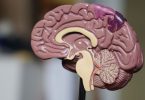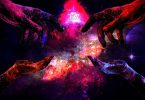We are living in a strange time where substances that we have been systematically indoctrinated to believe are toxic for us, are now being postulated as molecular messiahs. The US Food & Drug Administration, for example, has labeled the schedule I drug psilocybin as a “breakthrough drug” for treatment-resistant depression. Substances like cannabis, magic mushrooms, and dimethyltryptamine (DMT) are providing long overdue relief for medical conditions that traditional medicine has failed to conquer, and yet, each one is still wrongfully labeled as schedule I.
While DMT is often associated with the cosmic brew ayahuasca, researchers have speculated that our own brains may produce the substance. One such study found DMT concentrations in rat brains that augmented after induced, experimental cardiac arrest. [1] There’s also rumor that our brains manufacture DMT in the pineal gland, a pinecone-shaped organ located in the center of the brain, and that we produce more DMT during extremely stressful times in our lives, such as birth and death.
I first learned about the pineal gland in the same way that I learned about ibogaine… via a Hunter S. Thompson book where it was postulated that consuming an extract of the pineal gland would cause the following: “your head would swell up like a watermelon, you’d probably gain about a hundred pounds in two hours…claws, bleeding warts…” [2] Beautiful prose conjoined to the good doctor’s imagination.
The pineal gland is also called our “third eye” because of the way it can sense light and dark like our two observable eyes. The gland secretes melatonin, and melatonin helps regulate our circadian, or daily bodily rhythms, including feeling tired and waking up at somewhat standardized times of day.
Rene Descartes referred to the pineal gland as “the principal seat of the soul.” Dr. Rick Strassman proposed that DMT secreted from the pineal gland (the “brain’s own psychedelic”) is the “lightening rod for the soul.” [3] Strassman is a leading expert on DMT, and he published his research group’s findings after providing more than 400 doses of DMT to 60 volunteers in “the first sanctioned study on the clinical application of psychedelics in the US for a generation.” [4]
The reports of the experiences can be fantastically cosmic, with more than 50% of the volunteers describing “mystical” encounters with beings taking the form of “clowns, elves, angels, demons, aliens, robots and insectoids.” Clowns coming at you through some portal? Imagine!
Like psilocybin and ketamine, DMT has antidepressant [5], anti-anxiety properties [6], and is thought to be effective for sufferers of post-traumatic stress disorder [7]. DMT-containing ayahuasca is also used to help treat addictive behaviors. [8] These four societal scourges are so ubiquitous that it’s vital to identify and implement substances (especially plant-derived) that can help heal humankind at a rapid pace.
So, we have DMT that’s naturally in plants like Mimosa tenuiflora, Diplopterys cabrerana, and Psychotria viridis, all Central and South American shrubs, the latter of which comprises one-half of the traditional ayahuasca brew. As mentioned, DMT is a schedule I drug, and yet, scientists believe our own brains create the same illegal molecule?
In a paper on DMT, Graham St. John says of this illegality: “Integral to this view is the awareness of the absurd and unjust folly of prohibiting plants and their products that are themselves integral to an evolved consciousness. In the case of DMT—which occurs everywhere in nature, including the human brain—the folly is magnified when, under national and international legal frameworks implemented at the turn of the century, everyone is ostensibly born criminal.” [4]
But we are not criminals for creating DMT in our bodies any more than we are for manufacturing endocannabinoids. The real criminality surrounding DMT lies in the fact that it, and several other beneficent molecules, are still governed by the cruel absurdities of the schedule I classification. Substances that effectively combat mental illnesses and addiction, while simultaneously sparking creativity, empathy, and a greater connection to our fellow earthlings should be cherished for the treasures that they are.
References
[1] Dean JG, Liu T, Huff S, et al. Biosynthesis and Extracellular Concentrations of N,N-dimethyltryptamine (DMT) in Mammalian Brain. Sci Rep. 2019;9(1):9333. [journal impact factor = 4.379; times cited = 22][2] Thompson H. Fear and Loathing in Las Vegas: A Savage Journey to the Heart of the American Dream. 1971. Random House, New York.
[3] Strassman R. DMT: The Spirit Molecule: A Doctor’s Revolutionary Research into the Biology of Near-Death and Mystical Experiences. 2001. Park Street Press, Rochester Vermont.
[4] St.John G. The DMT gland: The pineal, the spirit molecule, and popular culture. International Journal for the Study of New Religions. 2017;7(2):153–174. [journal impact factor = 0.101; times cited = 5]
[5] Cameron LP, Benson CJ, Dunlap LE, Olson DE. Effects of N, N-dimethyltryptamine on rat behaviors relevant to anxiety and depression. ACS Chem Neurosci. 2018;9(7):1582-1590. [journal impact factor = 4.418; times cited = 51]
[6] Jacob MS, Presti DE. Endogenous psychoactive tryptamines reconsidered: an anxiolytic role for dimethyltryptamine. Med Hypotheses. 2005;64(5):930-937. [journal impact factor = 1.538; times cited = 87]
[7] Inserra A. Hypothesis: The psychedelic ayahuasca heals traumatic memories via a sigma 1 receptor-mediated epigenetic-mnemonic process. Front Pharmacol. 2018;9:330. [journal impact factor = 4.400; times cited = 24]
[8] Bouso J.C., Riba J. Ayahuasca and the Treatment of Drug Addiction. In: Labate B.C., Cavnar C. (eds) The Therapeutic Use of Ayahuasca. 2014. Springer, Berlin, Heidelberg.








